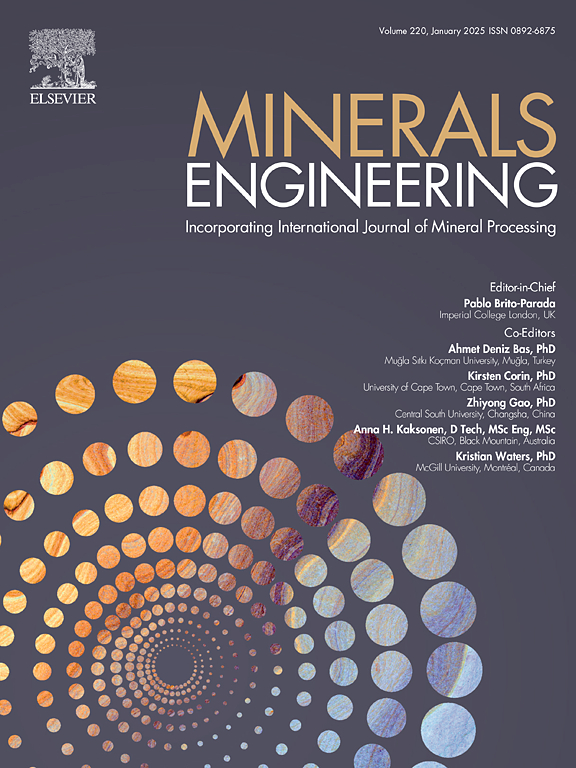紫草素在铜活化闪锌矿表面的抑制机理:选择性浮选分离的意义
IF 4.9
2区 工程技术
Q1 ENGINEERING, CHEMICAL
引用次数: 0
摘要
紫草素作为一种天然有机抑制剂在硫化矿浮选分离中的应用潜力尚未得到充分挖掘。本文采用微浮选试验、接触角分析、zeta电位分析、x射线光电子能谱(XPS)和飞行时间二次离子质谱(ToF-SIMS)等方法,系统研究了紫草素对闪锌矿和铜活化闪锌矿浮选行为的抑制机理。结果表明,紫草素对闪锌矿和铜活化闪锌矿均有明显的抑制作用。实际矿石试验铜精矿铜品位为18.71%、锌5.42%,铜回收率为85.23%、锌13.27%。Zeta电位和接触角测量表明,紫草素通过改变闪锌矿的表面电荷特性和润湿性,显著降低了闪锌矿的疏水性。XPS和ToF-SIMS分析证实了紫草素与铜/锌表面位点之间的螯合反应,所产生的配合物吸附在闪锌矿表面,有效地阻断了黄药捕收剂的吸附途径。本研究发现,SK通过含氧官能团(羟基(OH)和羰基(CO))化学吸附在矿物表面的Zn2+和Cu2+位点上,形成稳定的ZnOC和CuOC配位键,从而抑制了闪锌矿上铜离子的活化。本研究首次阐明了紫草素在闪锌矿浮选中的作用机理,为将天然有机化合物作为环保型抑制剂应用于矿物浮选提供了新的思路。为开发绿色高效的硫化物分离工艺奠定了理论基础和技术途径。本文章由计算机程序翻译,如有差异,请以英文原文为准。

Depression mechanism of shikonin on copper-ion-activated sphalerite surfaces: Implications for selective flotation separation
The application potential of shikonin as a natural organic depressant in the flotation separation of sulfide ores has not yet been fully explored. In this study, we systematically investigated the depression mechanism of shikonin on the flotation behavior of sphalerite and copper-activated sphalerite using micro-flotation tests, contact angle, zeta potential analysis, X-ray photoelectron spectroscopy (XPS), and time-of-flight secondary ion mass spectrometry (ToF-SIMS). The results demonstrate that shikonin exhibits significant depression effects on both sphalerite and copper-activated sphalerite. Actual ore tests yielded copper concentrates with grades of 18.71 % Cu and 5.42 % Zn, accompanied by recoveries of 85.23 % Cu and 13.27 % Zn. Zeta potential and contact angle measurements revealed that shikonin significantly reduces the hydrophobicity of sphalerite by modifying its surface charge characteristics and wettability. XPS and ToF-SIMS analyses confirmed chelation reactions between shikonin and copper/zinc surface sites, with the resulting complexes adsorbing onto sphalerite surfaces to effectively block xanthate collector adsorption pathways. In this study, it was found that SK chemically adsorbed on Zn2+ and Cu2+ sites on the mineral surface through oxygen-containing functional groups (hydroxyl (![]() OH) and carbonyl (C
OH) and carbonyl (C![]() O)) to form stable Zn
O)) to form stable Zn![]() O
O![]() C and Cu
C and Cu![]() O
O![]() C coordination bonds, leading to the depression of copper ion activation on sphalerite. This study is the first to elucidate the mechanism of shikonin in sphalerite flotation, providing new insights into applying natural organic compounds as eco-friendly depressants in mineral flotation. It also establishes theoretical foundations and technical pathways for developing green and efficient sulfide separation processes.
C coordination bonds, leading to the depression of copper ion activation on sphalerite. This study is the first to elucidate the mechanism of shikonin in sphalerite flotation, providing new insights into applying natural organic compounds as eco-friendly depressants in mineral flotation. It also establishes theoretical foundations and technical pathways for developing green and efficient sulfide separation processes.
求助全文
通过发布文献求助,成功后即可免费获取论文全文。
去求助
来源期刊

Minerals Engineering
工程技术-工程:化工
CiteScore
8.70
自引率
18.80%
发文量
519
审稿时长
81 days
期刊介绍:
The purpose of the journal is to provide for the rapid publication of topical papers featuring the latest developments in the allied fields of mineral processing and extractive metallurgy. Its wide ranging coverage of research and practical (operating) topics includes physical separation methods, such as comminution, flotation concentration and dewatering, chemical methods such as bio-, hydro-, and electro-metallurgy, analytical techniques, process control, simulation and instrumentation, and mineralogical aspects of processing. Environmental issues, particularly those pertaining to sustainable development, will also be strongly covered.
 求助内容:
求助内容: 应助结果提醒方式:
应助结果提醒方式:


